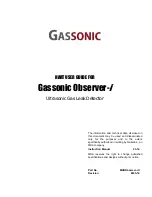
10
IK-E366-001
7.
OPERATION AND SERVICE CONDITIONS.
In accordance with the Regulation of the Minister of Interior and Administration of April 21, 2006 on
the fire protection of buildings and other construction facilities 2006 No. 80, item 563, technical
inspection and maintenance of gas detection systems ought to be conducted at least once a year.
Periodic inspection is recommended to be carried out once every 3 months and after the occurrence
of:
•
extreme operating conditions, i.e. high dust level, temperatures beyond the allowable range,
high concentration of detected gas,
•
long-lasting alarm condition,
•
after a long power supply interruption,
•
after renovation work.
Periodic inspection consists in:
•
checking the patency of the gas sensor cover and the condition of the seals,
•
periodic testing of detection functions, see 8.2.
In the case of renovation works, ASG-2000 detectors must be turned off and sealed with a foil. Any
solvent or silicone fumes are very harmful to the sensors.
As semiconductor sensors increase their sensitivity over time, it is recommended to calibrate
the sensor at least once every 3 years and in the case of frequent reactions to too low gas
concentrations. Electrochemical sensors decrease their sensitivity over time, and the long term of very
low humidity level or very high humidity level will have an effect on changing the sensitivity. It is
recommended to calibrate devices at least every 3 years.
!!! PLEASE NOTE
The expiration of the calibration validity period is indicated by a fault.
If you need to calibrate the sensors, the sensor module should be removed and sent back to the
manufacturer. The return of the module is the fastest and most economically justified way to ensure
full correctness of the sensor's operation. The calibrated sensor module will be sent back with a new
calibration certificate and a sticker informing about the type of sensor and the date of the next
calibration, which should be placed on the detector housing in the previous place.
7.1.
Sensor module replacement.
Disassembly of the sensor module:
•
disconnect the power supply,
•
disassemble the detector cover,
•
unscrew the sensor cover if present,
•
grip the sensor's plate with your fingers and gently pull it out,
•
mount the detector cover.
!!! PLEASE NOTE
Lack of the sensor module will reduce the protection of the enclosure to IP43.
!!! PLEASE NOTE
Connecting the power supply to the detector without the sensor module will result in
the FLT diode indication being signalled, and if the fault function is selected with the
jumper for selecting the A3/FLT output function, this output will be activated.
Installation of the sensor module:





























